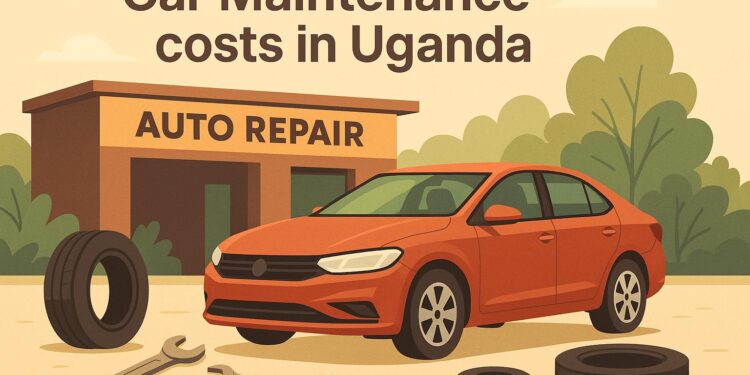Owning a car in Uganda can be expensive if you’re not prepared. Maintenance costs vary based on your car’s make, model, age, and where you live. Here’s a quick breakdown of what affects these costs and how to manage them:
- Car Type Matters: Budget-friendly cars like Toyota or Subaru are cheaper to maintain due to widely available parts. Luxury brands like BMW or Mercedes-Benz cost more because they require specialized care and imported parts.
- Location Affects Prices: Urban areas like Kampala charge higher labor rates but offer better access to quality parts. Rural areas have cheaper labor but may lack genuine parts or specialized tools.
- Regular Maintenance Saves Money: Simple practices like oil changes, tire rotations, and brake checks prevent costly repairs.
- Workshop Choice Impacts Quality and Cost: Authorized dealers are reliable but expensive. Independent specialists and local mechanics are cheaper but vary in quality.
Quick Tip:
Stick to a maintenance schedule, choose cars with easily available parts, and find a trusted mechanic to save money in the long run.
Read on for a detailed breakdown of costs, tips to lower expenses, and how to choose the right service provider.
Random Car Talk Thursday; The Real Cost of Owning a Car in …
Basic Maintenance Costs
After reviewing the factors that affect maintenance expenses, let’s dive into the basic costs specific to Uganda. These costs can vary greatly, and understanding them is key for vehicle owners to plan their budgets and make informed decisions about upkeep.
Standard Service Costs
Routine services, such as oil changes, brake pad replacements, air filter changes, and battery replacements, come with different price tags depending on where you go. For example, getting an oil change at an authorized dealership in Kampala will cost more than visiting a local mechanic. This price gap is largely due to the higher quality of parts, warranties, and service standards offered by dealerships.
Maintenance Costs: Budget vs. High-End Cars
The type of car you own plays a big role in maintenance expenses. Budget-friendly models like Toyota or Subaru are easier on the wallet because spare parts are widely available, and most mechanics are familiar with these brands. On the other hand, luxury brands like Mercedes-Benz or BMW require specialized care and parts, which significantly increases costs.
Location-Based Price Variations
Where you live also impacts maintenance expenses. In Kampala and other major cities, labor rates are higher, and quality parts are more accessible – leading to steeper service charges. Secondary cities offer moderate pricing, but finding specialists can be a challenge. In rural areas, while labor is cheaper, the lack of genuine parts and specialized tools can drive up the price for certain repairs.
What Affects Maintenance Costs
Car Make, Model, and Age
The make, model, and age of your car play a big role in determining maintenance costs in Uganda. Modern vehicles come with advanced features that improve performance but can make repairs more complex. Donald Lule, a Senior Lecturer at the Nakawa Vocational Institute, explains:
"We have such a better understanding of technology today than we did just five, 10, 15 years ago. Cars are built so systematically nowadays as well. Some people say that new cars are difficult to work on because everything is cramped and in the way, but things come apart way more easily than they did before. They can build a car in a few hours, and a well-trained technician can fully disassemble one just as quickly", – Donald Lule, Senior Lecturer with the Nakawa Vocational Institute
For example, something as simple as replacing a BMW battery might require a trip to the dealership for computer recalibration. Additionally, Uganda’s import laws only allow passenger vehicles that are 15 years old or newer, meaning cars must be from 2006 or later. These factors also tie into how supply logistics affect maintenance expenses.
Parts Supply and Import Fees
Many car owners in Uganda prefer to use authorized dealers, such as Toyota Uganda, for parts and repairs. However, these dealers often need to import specific parts, which can result in higher costs. Automotive expert Mustafa Ziraba highlights this:
"A number of new car owners always want the best for their car so they rush to the authorised dealer, say Toyota Uganda, who politely say that they do not stock that part but shall gladly import it just for you, at a price. Mention of this price more often than not makes you realise that you definitely need to explore other alternatives."
This reliance on imports not only increases costs but can also delay repairs due to supply chain challenges.
Service Quality and Workshop Choice
With roughly 2.3 million car owners in Uganda as of June 2022, the choice of where to service your car is crucial. Your options generally fall into three main categories:
| Workshop Type | Advantages | Considerations |
|---|---|---|
| Authorized Dealers | High-quality parts, trained technicians, warranty coverage | Higher costs, longer wait times |
| Independent Specialists | Affordable pricing, flexible services | Quality may vary, limited specialized tools |
| Local Mechanics | Lower labor costs, convenient locations | Possible use of substandard parts, less expertise |
Each option has its trade-offs, so choosing the right one depends on your budget and the level of service you expect.
sbb-itb-7bab64a
Service Costs by Type
Price List for Common Services
Here’s an overview of typical service prices based on vehicle type and workshop. In Kampala, costs for services like oil changes and brake pad replacements can differ depending on the type of vehicle and the specific workshop. Labor charges also vary depending on the location and the skill level of the technician.
Cost Range by Area and Car Type
Urban areas like Kampala and Entebbe often charge more for their services, offering quicker turnaround times and access to advanced tools. On the other hand, towns such as Jinja, Mbarara, and Gulu tend to have lower prices but may lack advanced diagnostic capabilities. The type of vehicle also plays a role – compact cars with easily sourced parts and simpler systems are generally less expensive to maintain compared to vehicles that need imported parts or have more intricate systems.
These differences highlight ways to manage and potentially reduce maintenance costs.
How to Lower Maintenance Costs
Now that we’ve identified what drives maintenance expenses, here are some practical ways to reduce them.
Regular Service Schedule
Stick to a regular maintenance routine to avoid expensive repairs down the line. For instance, aim to:
- Change oil and filters every 3,000–5,000 miles.
- Rotate tires every 6,000–8,000 miles.
- Inspect the brake system periodically.
- Replace air filters as needed.
- Check fluid levels on a consistent basis.
These simple steps can help you catch potential issues early and keep your vehicle running smoothly.
Choosing Easy-to-Maintain Cars
Opt for vehicles with parts that are easy to find and straightforward mechanics. When choosing a car, keep these factors in mind:
- Parts availability: Are replacement parts easy to source?
- Service network: Does the manufacturer have a wide service network?
- Maintenance complexity: Are repairs simple, or do they require specialized tools?
Pairing an easy-to-maintain car with dependable service providers can lead to even greater savings.
Finding Good Mechanics
A trustworthy mechanic can make a big difference in keeping repair costs in check. Look for workshops that offer transparent pricing and have verified credentials. Pay attention to the following:
| Factor | What to Look For |
|---|---|
| Equipment | Up-to-date diagnostic tools and proper maintenance equipment |
| Expertise | Certified technicians who know your vehicle’s make and model |
| Pricing | Clear estimates and detailed invoices for all services |
| Reviews | Positive feedback from customers and a strong local reputation |
| Location | Convenient access and fair labor rates |
Teaming up with a reliable mechanic not only saves money but also ensures your vehicle gets the care it needs.
Conclusion
Managing vehicle costs in Uganda comes down to smart decisions about the car you drive, how you maintain it, and who services it.
Sticking to a regular maintenance schedule is one of the simplest ways to keep expenses in check. Skipping preventive care often leads to bigger, costly repairs – especially important in Uganda, where replacement parts frequently need to be imported.
Your choice of vehicle also impacts your budget over time. Opting for fuel-efficient models with widely available parts can help reduce maintenance costs, particularly given rising fuel prices.
Equally important is finding a skilled and reliable mechanic. Having a professional who knows your vehicle well can help you avoid unnecessary repairs and ensure the job is done right. A dependable mechanic is a key part of any solid maintenance plan.
AutoMag.ug is your go-to source for updates and advice on keeping your car in top shape in Uganda. Taking care of your car today can lead to significant savings down the road.
FAQs
How can I find a reliable and skilled mechanic to service my car in Uganda?
To find a reliable and skilled mechanic in Uganda, start by asking for recommendations from trusted friends or family who have had positive experiences. This can help you identify professionals with a good reputation.
Additionally, check if the mechanic has formal training or certifications from technical schools or vocational programs. Experience matters too – ask about their specialization, such as engine repair or electrical work, to ensure they can handle your car’s specific needs.
Pay attention to their communication and transparency. A trustworthy mechanic will keep you updated on the progress of repairs and provide clear explanations about the work being done. It’s also a good idea to observe their professionalism and approach to customer service to ensure you’re in good hands.
What are some practical tips for reducing car maintenance costs in Uganda?
Managing car maintenance costs in Uganda can be made easier with a few smart strategies. Regular servicing is key – sticking to your vehicle’s maintenance schedule helps prevent expensive repairs down the line. Additionally, compare prices for spare parts and labor at different garages to find the best value, as costs can vary by region and service provider.
Consider using locally available or refurbished parts when appropriate, as these are often more affordable than imported ones. Also, practice good driving habits to reduce wear and tear on your car, such as avoiding aggressive acceleration and braking. Finally, staying informed about common maintenance issues for your specific car model can help you anticipate and budget for potential repairs.
How do Uganda’s import laws influence the cost and availability of car parts for maintenance?
Uganda’s import laws play a significant role in determining both the cost and availability of car parts. Import duties, which can go up to 25% on finished products, often increase the price of imported parts. Additionally, stricter regulations on used car imports, including safety and performance standards, can limit the variety of parts available locally.
The government has also banned the import of vehicles older than 15 years, which reduces the availability of certain older car parts. These factors collectively lead to higher maintenance costs and limited options for drivers in Uganda. To save money, many drivers opt for locally sourced or refurbished parts when possible.
Related posts
- 8 Essential Car Maintenance Tips for Uganda’s Climate
- Common Car Problems in Uganda: Solutions Guide
- How to Save Money on Used Car Maintenance
- Where to buy used cars in Kampala




